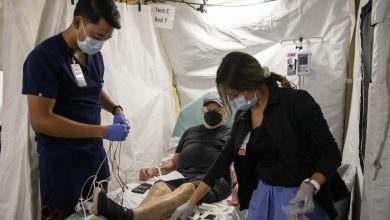Why Democrats Believe Health Care Could Be Their Secret Weapon in 2025

Introduction
As the United States barrels toward the pivotal 2025 election cycle, the Democratic Party is betting big on a familiar but potent issue: health care. From the Affordable Care Act’s early battles to the pandemic’s lessons, health care has consistently shaped voter priorities, divided Congress, and energized campaigns. Now, with costs continuing to rise, reproductive rights under fire, and public health challenges reshaping communities, Democrats see an opportunity to reframe health care as their ultimate political advantage.
Republicans are doubling down on culture wars and fiscal restraint, but Democrats argue that health care—an issue that directly affects every household—offers them the clearest path to re-engaging working-class voters, energizing their base, and winning over independents. For them, 2025 could be the year when health care becomes more than just policy—it becomes a secret weapon.
Why Health Care Remains the Democrats’ Strongest Card
1. Universal Impact
Unlike issues such as climate change or foreign policy, health care is personal. Every American, regardless of income, race, or geography, has experienced the health care system—whether through hospital visits, insurance premiums, or pharmacy bills. Democrats believe that this universality gives them an edge.
Polling consistently shows that health care is among the top concerns for voters. A 2024 Kaiser Family Foundation (KFF) survey found that 72% of Americans ranked health care costs as a “very important” issue in deciding their vote. Democrats want to capitalize on this, portraying themselves as the party willing to expand access, protect coverage, and tackle affordability.
2. A Proven Electoral Motivator
Health care has been an effective Democratic tool in past elections. In 2018, Democrats flipped the House of Representatives largely on the back of a unified message: Republicans wanted to repeal protections for preexisting conditions. That election cycle proved that when Democrats center health care, they win—especially in swing districts.
Now, with reproductive rights under siege after the Supreme Court’s reversal of Roe v. Wade, Democrats see a new health care flashpoint that can mobilize voters across demographics. In their framing, reproductive freedom is inseparable from health care access, and Republican restrictions represent government interference in the doctor-patient relationship.
3. Public Trust Advantage
Even amid polarization, voters consistently trust Democrats more than Republicans on health care. A Gallup poll in late 2024 showed a 12-point trust gap in favor of Democrats on handling health care policy. While Republicans hold advantages on issues like the economy and immigration, Democrats see their credibility on health care as a foundation for winning back skeptical moderates.
Key Health Care Themes Democrats Are Leaning On
1. Lowering Costs and Tackling Big Pharma
One of the most potent political weapons Democrats have is their legislative progress on lowering prescription drug costs. The 2022 Inflation Reduction Act (IRA) allowed Medicare to negotiate drug prices for the first time in history. By 2025, these negotiations are set to expand, with a list of high-cost drugs coming under new pricing frameworks.
Democrats plan to hammer this point home: they’re the party that took on Big Pharma, while Republicans opposed these reforms. By showcasing stories of seniors saving thousands on insulin and heart medications, Democrats hope to create a sharp contrast with GOP lawmakers who sided with industry interests.
2. Expanding the Affordable Care Act
The Affordable Care Act (ACA) remains the crown jewel of Democratic health care policy. While Republicans have largely abandoned their “repeal and replace” mantra, Democrats see room to expand. Proposals on the table include:
Making enhanced ACA subsidies permanent
Closing the Medicaid coverage gap in holdout states
Introducing a “public option” to increase competition
By highlighting ACA successes—like record enrollment in 2024—Democrats intend to remind voters that the law has become indispensable, despite its rocky beginnings.
3. Protecting Reproductive Rights as Health Care
Since the fall of Roe, Democrats have reframed abortion access not just as a matter of rights, but of essential health care. They argue that Republican restrictions endanger women’s lives, force doctors into impossible ethical dilemmas, and create chaos in emergency rooms.
In states like Kansas, Ohio, and Michigan, voters have shown a willingness to protect abortion rights via ballot initiatives, even in conservative territory. Democrats plan to nationalize this momentum, tying reproductive freedom directly to their broader health care agenda.
4. Mental Health and Addiction Services
The pandemic worsened America’s mental health burden, while opioid addiction continues to devastate communities. Democrats see an opening here: by championing expanded access to mental health services, telehealth, and substance abuse treatment, they can appeal to suburban families, rural voters, and young people alike.
Framing mental health as “health care, not weakness” also allows Democrats to soften their image among independents and conservatives who are wary of government expansion but recognize the urgency of the crisis.
Republicans’ Weakness on Health Care
Democrats believe Republicans are vulnerable because the GOP lacks a clear, popular health care agenda. After the failure to repeal the ACA in 2017, Republicans largely stopped offering comprehensive health care proposals. Their focus shifted to tax cuts, deregulation, and cultural issues.
This leaves them exposed in several ways:
No alternative to ACA: Republicans criticize health care costs but rarely provide credible replacements for existing programs.
Opposition to drug price negotiations: GOP lawmakers almost uniformly opposed provisions that lowered costs for seniors.
Abortion restrictions: Many Republicans support strict bans, putting them at odds with majority public opinion.
Democrats intend to paint Republicans as the party that threatens health care security—whether through undermining ACA protections, siding with drug companies, or restricting women’s choices.
How Democrats Plan to Make Health Care Their “Secret Weapon”
1. Storytelling Over Statistics
Rather than overwhelming voters with policy jargon, Democrats plan to highlight personal stories: a grandmother who can now afford insulin, a young woman denied reproductive care in a crisis, a veteran struggling with PTSD who finally accessed telehealth services. These stories humanize policy wins and underscore the stakes of elections.
2. Linking Health Care to Economic Security
Health care isn’t just about doctors and hospitals—it’s about family budgets. Democrats want to emphasize that lowering drug prices and expanding coverage puts money back into people’s pockets. By tying health care to the broader economic narrative, they hope to neutralize Republicans’ advantage on inflation and jobs.
3. Targeting Swing Voters in Key States
In battleground states like Michigan, Pennsylvania, Wisconsin, and Arizona, health care consistently ranks high on voter priority lists. Democrats plan to saturate these areas with messaging that contrasts their efforts to protect coverage with Republican attempts to roll it back.
4. Mobilizing Young and Female Voters
Health care issues—especially reproductive rights and mental health—resonate strongly with younger voters and women. Democrats believe energizing these groups is essential not just for presidential races but for down-ballot contests that will decide control of Congress.
Potential Risks for Democrats
While Democrats are confident, relying too heavily on health care carries risks.
Voter Fatigue: After years of debates around the ACA, some voters may tune out unless messaging feels fresh.
Unrealistic Promises: If Democrats overpromise on lowering costs or expanding programs, they risk backlash when results fall short.
Republican Counterattacks: The GOP could pivot, emphasizing failures in Democratic-run states (like high premiums or long wait times) to undermine the message.
Economic Overshadowing: If inflation or recession dominate headlines in 2025, health care may not be the deciding factor.
Democrats will need to balance their health care push with credible economic messaging to avoid appearing one-dimensional.
Looking Ahead: Health Care as the 2025 Battleground
The 2025 election cycle is shaping up as a test of which issues voters prioritize most. Republicans are banking on cultural fights, immigration, and the economy. Democrats, however, believe health care gives them both a defensive shield and an offensive weapon.
Defensively, it allows them to protect their core brand as the party of compassion and fairness.
Offensively, it puts Republicans on their heels, forcing them to defend unpopular stances or vague proposals.
If Democrats succeed, health care could once again prove to be the “kitchen table issue” that decides control of Congress, shapes the presidency, and sets the legislative agenda for years to come.
Conclusion
Democrats have long seen health care as a cornerstone of their political identity. In 2025, they believe it could be more than that—it could be their secret weapon. By highlighting cost reductions, defending reproductive freedom, expanding mental health services, and portraying Republicans as indifferent or obstructive, Democrats aim to connect with voters on the most personal issue of all: their health.
Whether this strategy will deliver electoral victories remains uncertain. But one thing is clear: in the battle for America’s political future, health care is not just a policy debate—it’s a defining narrative, and Democrats are determined to make it their winning story.




